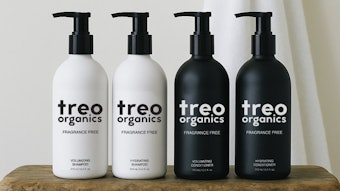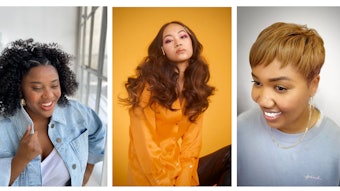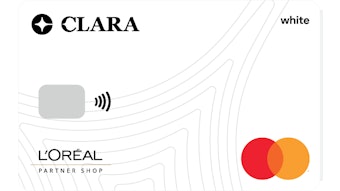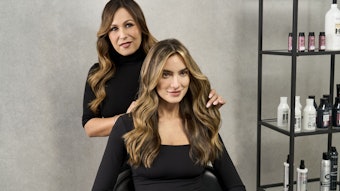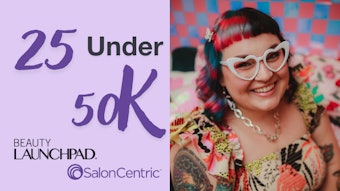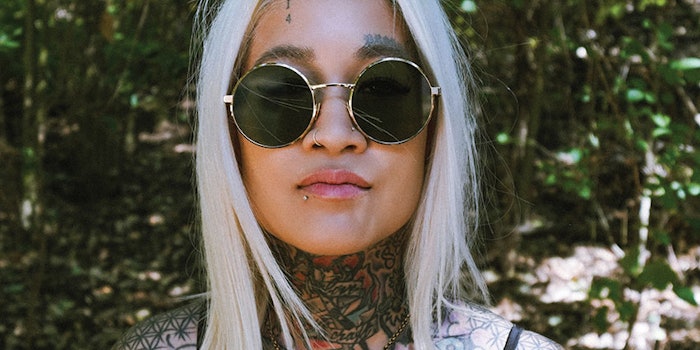
The network of tattoos that travels along barber and STMT Grooming Goods creator Sofie “Staygold” Pok’s (@staygold31) arms, around her back, up her neck, across her scalp, trickling onto her forehead—they all hold memories. One (her first) was a mistake—a 19-year-old’s youthful misstep in a “dirty, sweaty house in Bakersfield, [California]” when rebellion motivated the inking rather than a true desire for permanence. “I hid that tattoo for a whole summer from my parents,” Pok admits. This wasn’t a small tat; it covered an oblong piece of real estate on her forearm—not easy to hide during the warm season in Southern California’s Anaheim, where Pok was born and raised. “I wore long sleeves all summer. My parents were like, ‘Are you not hot?’ I was dripping sweat,” she laughs. “It was just one of those things when you’re young and you’re like, ‘What would happen if I got a tattoo?’” The tattoo’s eventual discovery caused a growing fault line between Pok and her strict Cambodian parents to fracture even farther—but that tattoo serves as a memento for Pok all the same. She eventually covered it, but the story remains.
From Gratitude to Defiance
That memory touches upon Pok’s upbringing—a far cry from how you might assume the barber phenom grew up. Pok’s mother escaped Communist rule in Cambodia with her siblings, fleeing to the United States in pursuit of freedom. Through a lucky loophole, Pok’s uncle found necessary American sponsorship for himself—yet demanded that his entire family be sponsored as well. “My uncle was so brave at that time, which is crazy, because he was only in his 20s,” Pok says. “It would have been very different [if he didn’t bring my mom].” What her mother overcame shaped Pok as a person—and as a barber and businesswoman. “I learned to have gratitude for every little thing because my mom had so much taken from her,” she says. “I think [my mom’s experience] allows me to have a little bit more perseverance and perspective; I’ve seen what my mom has gone through and, when I’m in conflict, it doesn’t feel like it’s paralyzing. I think what I’ve taken from my family is being able to roll with the punches and keep going.”
Pok also learned defiance. While her parents foresaw a specific track for their daughter—a higher education that commenced in a “secure” field, like a doctor or lawyer—she turned toward creativity. But she didn’t rebel all at once; she attended college, majoring in business studies, and simply didn’t feel connected to the curriculum. “I had a falling-out with my family the second year of college. I just couldn’t do it anymore. And they told me, ‘Fine, make your own choice,’” Pok recounts.
Up to that very point, Pok’s path had always been predetermined for her. But here she was, finally able to strike out on her own. “It was trippy because you feel awake for the first time. You’re like, ‘Wait … I … what … which way?’” she laughs. While pouring her heart out to a college friend about her metaphorical fork in the road, the friend made a simple request: Will you cut my hair? “I had no prior experience. But, it just kind of clicked,” Pok says. With clumsy orange-handled paper-cutting scissors, Pok trimmed away and her friend, satisfied with the cut, suggested Pok pursue cosmetology school. “That was when the light bulb went off,” Pok says.
The Cosmetology Year
One of the aspects of cosmetology school that enticed Pok: It’s only a yearlong program. Having watched her aunt pursue seven years of pharmaceutical school only to switch careers scared Pok. She wanted a faster track. “If it works, it works. If not, then we can ship it again. And that was my entryway into the industry,” she recalls.
Cosmetology school wasn’t without its hurdles—the biggest one being completely outside of the training. Quite simply: Her parents didn’t approve. “Me choosing to take this creative field felt like risking it all—like jumping off a cliff,” Pok says. Though her parents told Pok she’d have to go it alone, she feels that her mother supported her—even though she didn’t understand Pok’s choice. “She must have [supported me]; she drove me every day to cosmetology school!” she laughs.
Beauty school unleashed something inside of Pok—a fun, experimental side that chipped away at her shyness. She’d always subscribed to her mom’s vision of beauty: long brown hair, no shaving (even of legs and arms), prim and proper. But at cosmetology school, she broke free. “I think it was the first time creatively I started shifting my physical looks into something completely different,” she remembers. Bold blonde chunks, a haircut that crept up shorter and shorter—it was a freedom of expression she’d never experienced before.
What About Barbering?
Her comfort behind the chair grew as well, and when she finally completed cosmetology school, Pok bopped from one salon to the next, trying to find her groove. She started down the expected hairdresser path—assist a busy stylist, decide whether you want to cut or color—but she didn’t feel fulfilled. “How do I know what I want to be when I’ve never really done it?” she asks. Pok gravitated toward color because word on the street said that’s where the money’s at, but not before long, she found herself again at a fork in the road. “Is this actually what I want to do?” she asked herself. “I didn’t know if I loved it.”
Before she skipped out on hair altogether, Pok thought long and hard about her year in cosmetology school. “I was always more attached to cutting,” she says, which led her to explore barbering. “When I look back now, I always got all of the short cuts in beauty school. Every one of my classmates was just like, ‘Oh, I don’t want to do this short cut. Let’s give it to Sofie.’ It was already happening before I even knew it,” Pok says. She now looks at old photos of her mannequin work at school and sees skin fade after skin fade. “I was giving them skin fades and I didn’t even know what I was doing. Yeah, it’s kind of crazy,” she laughs.
The Cosmetology-Barber Hybrid
After a brief stint in a small established barbershop where a stiff set of cutting rules and a boys-will-be-boys attitude prevailed, Pok lucked upon a Craigslist ad for American Barbershop in Santa Ana, California, in 2011. The owner, a former stylist-turned-barber, took a cosmetologist-friendly approach, allowing Pok to nurture the strengths she’d learned in beauty school—cutting longer hair—while she cultivated her own approach to barbering. “When I started working there, guys had short buzz cuts and fades; scissor cuts weren’t necessary,” she recalls. Then, the styles changed; men came in desiring longer cuts—and Pok was just the person to deliver on the request. “I started to notice the need for the cosmo-barber hybrid; why not fill that need?” she says.
She attributes part of her growth to the family-oriented atmosphere of American Barbershop. “It helped me feel more comfortable. So many shops in that area had this feel of a tattoo shop, where you walk in and people are just a little bit cold,” she says. Whether she knew it or not, those formative four years working at American Barbershop cultivated an openness to share her techniques—an attitude that would serve her well in the digital age.
Breaking the Barber Barrier
Any comfort Pok felt at American Barbershop didn’t necessarily translate to the barbering world at large; the community didn’t open its arms to her—not initially, anyway. “It was as tough as people see it as,” she admits. “I think I struggled with guys just assuming that I’m a stylist first. If they see a girl in a barbershop, they’re like, ‘Oh, you must be a stylist.’ But, no, I actually do barbering, and they just couldn’t believe it.” Male peers, clients and owners would overlook her because of her gender. Case in point: A fellow male junior barber with less experience (and talent) would receive walk-ins over Pok. “It wasn’t about being judged on our work. It was all gender,” she says.
The pushback she received galvanized her to build an online portfolio on Instagram in 2012, during the platform’s infancy. Over the next year and a half, she steadily built her feed as well as her clientele. “The cool thing with barbering versus a salon is guys come in for maintenance once a week or every other week. When you’re learning, it’s much more fast-paced, and you gain so much more repetition in that kind of working environment. Your skills are bound to get better from all that practice,” Pok says. More practice, more posts, more visibility: It all started to come together.
Just a Barber
The better she became, the more her star rose on Instagram—but being female continued to present challenges in her field. “When I’m teaching classes, it’s hard for some guys to just say, ‘Hey, I want to learn from you.’ It’s almost hard for some people to just admit it,” she says. In the beginning of her career, the singling out of her gender bothered her—the bad aspects, of course (being overlooked, being discounted by peers, being labeled a stylist) and the good (being propped up by media, being highlighted because of her sex). “I think that now I’ve gotten to a place where I accept that both sides exist,” Pok shares. “The hardest thing for me is to not overthink those things. Because in the moment it can be so overwhelming; in your head you’re like, ‘I’m just working hard because I want it.’ I want to prove to myself that I can do this, but you’re also battling people who want to discredit you.”
It’s not shocking, then, that Pok is most proud of her 2017 American Influencer Award for Barber of the Year—simply because it doesn’t call out her gender. “I think that’s a goal for a lot of females in this industry,” she says. “One of the most asked questions I get from other female barbers around the world is, ‘How do we not be known as a female barber and just be known as a barber?’ Because I think that, when it comes down to it, we all just want to be equal. We don’t want people to say, ‘Oh, you’re pretty good … for a girl.’”
If You Build It …
Part of Pok’s success can be attributed to her openness on Instagram. In the beginning, the feed became a place to catalog her work, but as time passed, she morphed her content to shed light on how cool and complex barbering is. “I always felt like, man, if people actually knew how amazing this field is, they’d want to learn more about it and look up to it more,” Pok says. Barbers—especially females—would DM her, expressing how Pok’s feed inspired them to enter barbering. Her candidness and zeal for sharing techniques on Instagram began to open up opportunities working with brands, like BaBylissPRO, where she remains an educator, and even Foot Locker, El Pollo Loco and Dell XPS. Not to mention, a wide-reaching network of other barbers and stylists throughout the world began to form around Pok, sharing techniques, collaborations, stories, triumphs and struggles.
But, of course, the darker side of social media exists, and it’s one that Pok tries to fight back. “Instagram is like a highlight reel,” she explains. “I think a lot of people who haven’t gotten the success they want may not understand there’s an entire backstory to how someone got to the point that they’re showing on Instagram.” And, with the introduction of TikTok, Pok feels the viral churn-out is more burnout at this point—not to mention, “there’s even more false expectations of what it can do for you,” she laments. In other words, not everyone becomes a celebrity barber overnight from a few posts; the grind behind the scenes is very real.
What’s Next: In This Together
And that grind continues for Pok, who launched STMNT Grooming Goods with fellow barbers Julius Cvesar (@juliuscaesar) and Miguel Gutierrez (@nomadbarber) in September 2020—amidst a global pandemic, no less—and whose next big project focuses on education: Staygold Education (follow @staygold31 for updates). “It’s actually really fun to help people understand how to go from point A to point B. I think that, because I struggled in the start, to help someone go through [learning] faster makes it fun for me,” she says.
With her pre-COVID-era barbering show schedule slowed, Pok found herself teaching people online about the business side of barbering—like cultivating a smart social media strategy and building a personal brand—and really enjoyed it. Her new online education platform will feature these types of business classes, plus tool knowledge and barbering tutorials that Pok has simplified for students to pick up quicker. “I also want to include situational demos—like, if you get a bad Yelp review, what do you do?” she says. “I want to include these little simulations because these are situations that I personally went through, too.” She pauses. “I think people forget that all of us struggle. People relate better when they know you’ve been through that struggle, too. It’s like, ‘Oh, Sofie went through this—it’s not so bad.’’’
For Pok, that feeling of “we’re all in this together” is one she hopes to foster in her field. Beyond leaving a legacy of inclusiveness, she seeks to shake up and elevate the industry—she is known as a disruptor, after all. “I want to make people feel like there’s a new standard for barbering; barbering doesn’t have to be cheap,” she says. “After being in barbering for so many years, the one thing I notice holding most people back is they don’t believe in themselves enough to know that they’re worth more. With Staygold Education, I want people to trust in themselves enough to build the skills necessary to elevate themselves and the industry. It’s going to have to be a collective of people pushing for higher standards … and anybody can do it. Knowing my background, I get shocked sometimes that I was able to have gotten this far. It’s just a little bit of work every single day. Then, one day you wake up and you’re surprised how far you’ve gotten.” With Pok awake, the barbering industry has a fierce ally.
That Style, Though
Pok’s style can’t be denied. Here, she answers some of our burning questions.
Beauty Launchpad: What does your nickname “Staygold” mean?
Sofie Pok: I wanted a tattoo that fit on my knuckles, and at the time, I had just gotten out of a really bad relationship. And one of the things I struggled with growing up is that I’d always adapted to whoever I was with—in the process, I’d lose myself. “Stay gold” is a famous quote [from S.E. Hinton’s The Outsiders] that means something like, “Be true to yourself no matter what.”
BLP: What does being tattooed mean to you?
SP: It’s physical and emotional pain at the same time. The act of getting tattoos can be therapy for me.
BLP: What inspires your hairstyles?
SP: I think when I’m blonde, the color eventually turns a little dingy. So having it [fashion] colors just makes it look more intentional versus dingy yellow-blonde, you know? Every color change always makes me feel new again.
BLP: What’s your favorite brand of beanie?
SP: In Santee Alley in the Los Angeles Fashion District these little shops sell a bunch of blanks that you can private label. I actually don’t even know the brand. They’re just regular blanks and you can find a ton out there for four bucks apiece!
Making a STMNT
Launched September 2020 by Pok, Arriola and Gutierrez, STMT Grooming Goods (@STMNTGROOMING) captures the evolution Pok dreams of for the industry. Sophisticated, lifestyle-driven and genderless, the groomingandbarbering line harnesses 14 high-performance formulas that answer unmet needs for the modern barber. Here’s a breakdown of Pok’s Staygold Collection, created to enhance “next-level texture styling.”
STMNT Spray Powder: Lightweight with an extreme matte finish, this spray instantly lifts roots and offers incredible grip.
STMNT Wax Powder: This medium-control powder-to-wax styler applies evenly down to the roots.
STMNT Fiber Pomade: A strong-hold, pliable formula allows infinite moldability.
